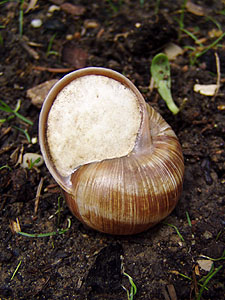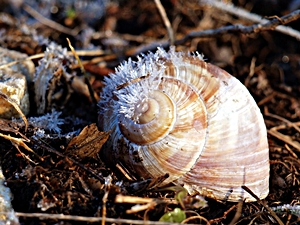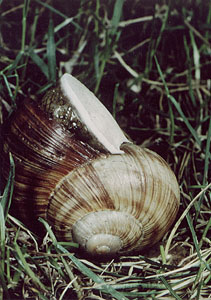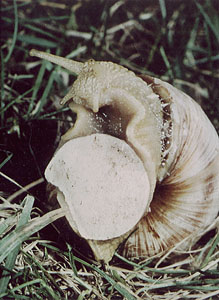
The winter lid not only protects the Roman
snail against frost, but against desiccation as
well. Source: schneckenzucht.de.
When nights become longer and days shorter in autumn, the Roman snail must also begin to prepare for winter. Only by hibernation is it that the snail will survive the frosty temperatures of Central European winters.
 The winter lid not only protects the Roman snail against frost, but against desiccation as well. Source: schneckenzucht.de. |
At a place protected from the wind, covered with vegetation, the Roman snail begins to dig a hole in the ground to hibernate in. Digging with the foot, supported by drilling motions of the shell, the snail makes a hole that resembles the hole its life began in as a freshly hatched young snail. Only this time the snail withdraws into it, to endure winter – to hibernate. From the surrounding surface the snail pulls vegetation into the hole to further isolate it against the cold. Finally the hole is closed from inside with earth. Now the snail has to prepare to endure the frosty temperatures of winter.
First it produces a calcareous secretion from glands in the mantle fold closing the shell mouth. This calcareous secretion hardens and makes a lid, called an epiphragma, which now closes the shell mouth. The shell mouth is not closed hermetically, because otherwise the snail would suffocate in its shell. If, for an experiment, the shell lid is covered with wax, the snail will push it away and come out to breathe.
 At the surface, Roman snails can hardly survive the winter frost (in a dry grass land in Bad Vöslau, Lower Austria). Picture: Roberto Verzo (Source). |
Inside the shell, behind the lid, the snail withdraws further into the shell and doing so exhales. The air between the snail and the lid makes a further isolating layer. Sometimes the snail withdraws several times exhaling and spanning membranes of mucus between packets of air.
In its winter hole, the shell mouth closed by a hibernation lid and the shell further isolated by air packets inside, frosty temperatures can do little harm to a Roman snail. In a sequence of experiments on the frost resistance of terrestrial snails it has been discovered that Roman snails can endure temperatures as low as -40°C, if the shell mouth is closed by a hibernation lid. It is, however, hard to believe, that this alone leads to such an outstanding result. But truly the lid stops ice from entering the shell and harming the snail. But, when the temperatures are low enough, the snail may partially freeze.
Actually there are prominent physiological changes in a Roman snail during winter. And those mainly are what ascertain the snail's survival even through the lowest temperatures. At first, the snail parts from all the water it can spare. Through the rest of the year the snail will always try to avoid water loss of any kind. But in hibernation, water potentially will freeze to form ice and to damage the snail's organism. Additionally the decrease of water raises the ratio of dissolved particles per volume water. That way the snail produces its own antifreeze. It even strengthens it by dividing large molecules in its blood, such as proteins, into several smaller ones. Even surplus molecules of the blood pigment haemocyanin are decomposed during hibernation.

 When temperature and humidity increase in spring, the snail awakes and comes out of its winter quarters. Using its foot it pushes away the lid and comes out of its shell. |
To keep energy consumption low during hibernation, all superfluous body functions of the snail are reduced to almost zero. For example the heart beat rate decreases from 36 beats per minute in an active snail to 3-4 beats per minute in a hibernating one, thus reducing oxygen consumption to 2%!
Excretion continues in the snail's kidney. Only the uric acid is stored in the kidney's tissue and excreted by and by after waking.
While a Roman snail's hibernation period is induced by the decreasing length of daytime periods, reduced food supply and the outside temperatures falling below 8 °C, hibernation ends with the outside temperature climbing above an average of 8 °C in spring. Then the snail's physiology returns to active state. The snail begins by breaking the membranes between the air packets and finally pushes off the lid.
When they are just awoken from hibernation the snails are famished and dehydrated. During hibernation a snail may loose 10 to 15% of what they weighed at the beginning. A Roman snail may recover 50% of its original weight in two days after waking up. To recover all of its weight, it will need several weeks. As it is also deprived of calcium carbonate, the snail now is not able any more to build another winter lid. Late frosts in spring can therefore result in massive losses among the just awoken snails.
Usually numerous winter lids of snails can be found in the same place – a sign that snails usually keep together, when they are hibernating.